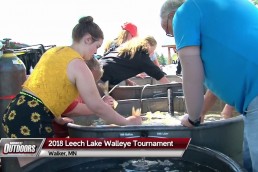Webster Lake Muskie Study aims to Revive Popular Fishery
SHARE THIS POST
Indiana’s famed muskie fishery got a check-up this fall as fish managers try to restore the fabulous fishing of a few years ago.
That’s not to say it’s bad right now. In fact, we’re in primetime muskie fishing on those Kosciusko County lakes that attract anglers from around the Midwest. Several 45-plus and 50-inch fish have been caught this year.
In case you didn’t know, Webster Lake has been one of the Midwest’s best muskie fisheries for several years. Anglers drive here from Ohio, Illinois and southern Indiana to fish for the monster fish.
When it was in its prime, it was nothing for a good muskie angler to hook up several fish in a day, not to mention attract numerous, nerve-racking follows. However, the muskie fishing has been declining in recent years, especially after lake residents killed the aquatic plants with a devastating application of high-powered chemicals in 2010. The lake turned the color of “chocolate milk” and fishing declined considerably for all gamefish.
Fortunately, other nearby lakes, like Lake Tippecanoe, the Barbee Chain and Skinner Lake took up some of the slack. They also get stocked with muskies, but have never produced the quality fishing of Lake Webster.
“The weed treatment really hurt this community and the businesses that rely on the muskie tourism,” said Todd Sautter, owner of the Tackle Box tackle store in North Webster. “But the fishery is starting to come back now that the vegetation is returning and the water is clearing.”
The Lake Webster situation exemplifies what happens to a lake when people get overzealous with harsh chemicals. The weeds die and disappear and the lake can loses its clarity—young fish have no place to hide from predators. Fish get bigger, but numbers of catches diminish.
And that’s been a huge concern for biologists and anglers alike. Webster always has produced big fish, but until this year, not many young fish were being seen or caught.
Historically, the DNR has stocked 3,800 muskies about 10 inches long each fall.
That seemed to work fine for a while, but the immature muskies stopped showing up in the catches.
Are you enjoying this post?
You can be among the first to get the latest info on where to go, what to use and how to use it!
North Webster muskie guide Chae Dolsen said he went through a five-year period when he never caught a muskie under 30 inches, but this year caught 40 of the juveniles.
“I think it’s on the mend, and in a couple of seasons it will be fantastic,” he said. “The increase in size limit has helped (along with the return of vegetation), but I still think there are some stocking issues.”
Biologists are concerned and are planning to experiment with stocking methods this year. Only 2,300 fish were stocked in late October and the remaining 1,500 will be given a chance to grow larger in the hatchery before they are stocked this spring. They will be tagged so fish managers can monitor the success of the fall and spring stockings.
In addition, a creel study, in which a DNR employee will be interviewing anglers about their successes, was conducted last fall.
Dolsen and others believe part of the problem also includes the diet of the muskies while they are in the hatchery. Years ago, the DNR switched from a pellet food to minnows 90 days before the muskies were stocked. In a cost-cutting measure, the number of days they were fed minnows was reduced to 30.
Dolsen’s statistics show a downturn in numbers of fish being caught after the DNR changed the diet. He believes fish-fed minnows get fatter and know to target forage once they are stocked, thus they survive better than those kept on a pellet diet for extensive periods. His muskie club has proven it with their own private muskie stocking on a smaller lake.
Muskie biologist Jed Pearson hopes that holding back some of the young fish for a spring stocking will be a cost-effective solution. It has proven successful for other states, but he admits it will take a few years of the experiment to determine its success.
In the meantime, you might want to consider a trip to the Barbee Chain, Webster, Tippy, or Skinner lakes later this fall, or before, with colder temperatures. Cool weather gets the muskies feeding shallow, and the big fish are there. You just might have to work a little harder for them.
Louie Stout is a Hall of Fame journalist and longtime “Bassmaster” Senior Writer who has covered Indiana and Michigan outdoors for more than 40 years. He’s co-authored three books with Kevin VanDam and is the outdoors columnist for the South Bend Tribune.
To learn more about current fishing conditions, call the Tackle Box at 574-834-2011. To contact Dolsen, visit his website at websterlakeguideservice.com.
MWO
SHARE THIS POST
Did you enjoy this post?
You can be among the first to get the latest info on where to go, what to use and how to use it!
Louie Stout
Louie Stout is a Hall of Fame journalist and longtime Bassmaster Senior Writer who has covered Indiana and Michigan outdoors for more than 40 years. He’s co-authored three books with Kevin VanDam and is the outdoors columnist for the South Bend Tribune.


